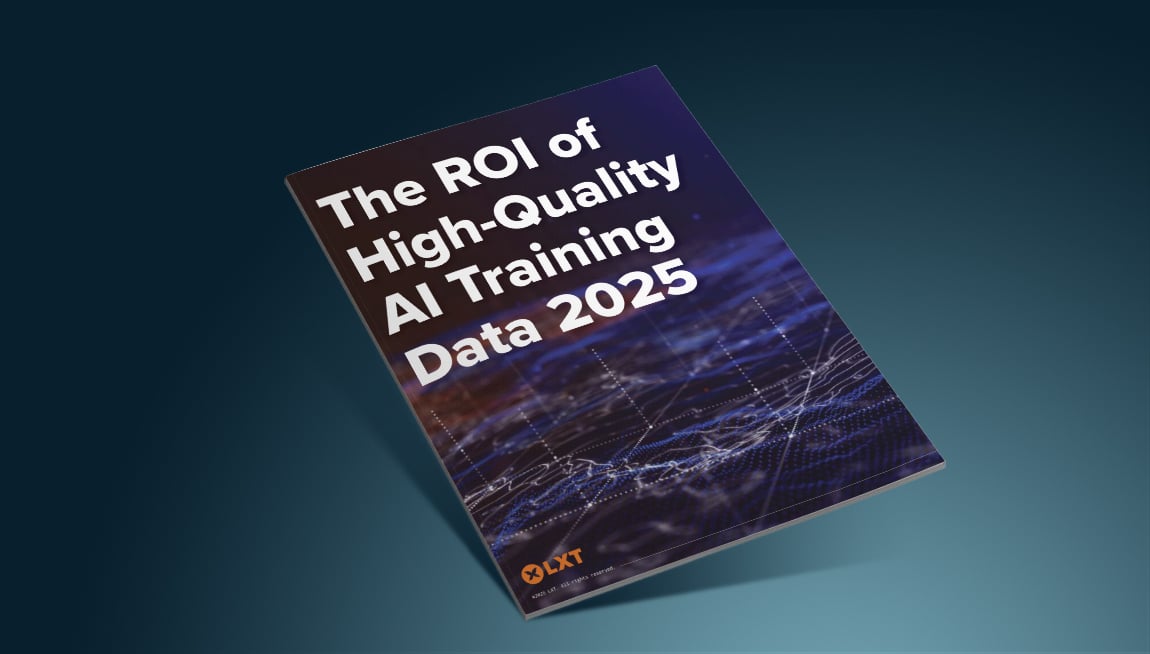At the end of 2021, Gartner forecast that the market for artificial intelligence (AI) software would reach $62B in 2022, much of it certainly driven by AI’s remarkable ability to learn and solve problems. AI has helped companies launch breakthrough innovations with consumer experiences that are highly tailored to meet user needs and understand their intent on a uniquely personalized level. But AI’s usefulness and problem-solving prowess are not innate – data is essential to its effectiveness. And the ultimate success of an AI application’s outcomes hinges on the soundness of the data used to “train” the machine learning algorithm it is based upon. To support the development of a particular AI application, companies need a well thought out data strategy, from the type of datasets for AI that are needed, and how they’ll generate or procure them, to how they’ll clean, manage and secure them—as well as how to structure and label them.
Without a thorough, well-executed data strategy, organizations may not have the breadth, depth or quality of data needed to adequately train a machine learning algorithm. And without a well-trained algorithm, the most well-designed chatbots, home assistants, search engines, and other apps and solutions will fall short of providing a useful end user experience.
The role of datasets for AI in product development
Collecting, correcting and annotating data for an AI application should start from the earliest stages of development. The following steps provide a guideline for how product teams should think about data as part of the product development process.
Designing the prototype:
While designing the prototype for a new product or service, companies should simultaneously develop a data strategy for their AI solution that identifies: 1) the type of data they need, 2) how to ensure, and build confidence in, the quality of the data, 3) opportunities to diversify data sources and how often they need to retrain their algorithms, 4) where they will source data from 5) how it will be prepared for use in training the algorithms. These parameters might change over time, but creating a robust data strategy up front in the product development lifecycle is critical to meeting launch timelines and creating products that delight customers. And a key consideration in the development of the data strategy is involving the right stakeholders, which could involve both internal and external teams.
Collecting data:
Whether data needs to be collected depends, in part, on the type of product or service you’re developing. With an effective data strategy in place, you can better anticipate your needs. If you don’t have sufficient data in-house, and don’t have access to second-party data from a business partner, then consider acquiring it from a third-party provider. When choosing a provider, consider how they’ve sourced or collected the data, the scale of the data they can provide, their reputation, and the quality of the data.
Labeling and organizing data:
Once the data is collected, it must be organized and labeled so that the machine learning algorithm can more easily recognize it and begin making a reasoned hypothesis—a best guess, about the end user’s intent. Often, companies can handle some portion of their data labeling in-house, and there are good reasons to do so, not least being that proximity to the data can offer insight into user behaviors and preferences. But it may also make sense to make outsourcing a part of your data strategy. Motivating factors for this could include exponential growth in data requirements; parallel expansion into multiple languages to support a global rollout; and reduction of data annotation bias by having the work carried out by annotators who are at arm’s length from the organization, and can provide neutral interpretation of user intent, uncolored by an understanding of, or closeness to, the end product.
Training the algorithm:
At this stage, a data pipeline should be established with enough examples to create a dataset and provide a foundation for the algorithm to begin learning. The algorithm will then analyze the dataset, specifically looking for patterns and relationships in the data. Then it makes predictions based on its understanding of the data. With more time and more data, its ability to make accurate decisions increases.
Deploying the application:
When the product team is satisfied with the algorithm’s accuracy rate, they release it to the market or deploy it in a production environment. Companies typically establish an initial accuracy rate by comparing it against a baseline or basing it upon the potential impact to the user, the company’s business goals, or any relevant safety considerations.
Collecting live data:
After an application has been deployed, an algorithm should be iteratively retrained. This is achieved by collecting real user data, and annotating it–in effect, making corrections, refinements, enhancements, and updates to the application output–and using this as a (re)training data set. This iterative process provides confirmation of what the application is getting right, making it more robust and able to get the same things consistently right in the future.
Improving the experience:
When the data has been corrected and annotated it’s sent back to the product team, which can update the algorithm and continue to refine the user experience.
The role of datasets for AI in product enhancement
Once a product is launched, data continues to play a role in retraining the machine learning algorithm. As the user base expands, and the demographics and user behavior move away from the initial training dataset, machine learning models may drift. In this case, new training data will be needed to maintain and improve the prediction accuracy.
Much like the process above, live data is collected (both the data generated by a user’s actions, and the algorithm’s prediction, or hypothesis, of that data), it’s corrected and annotated to highlight the algorithm’s mistakes, and is then used to retrain the algorithm to improve its level of accuracy.
Rinse, repeat
Ensuring a useful and engaging AI experience for end users requires a continued commitment to annotate and correct your algorithm’s recognition hypotheses. Depending on the context in which your machine learning algorithm operates, this could mean correcting and annotating it on a monthly, a weekly, or even a daily basis. Variables such as time horizon and operational context dictate how often an algorithm should be corrected and annotated.
For example, an algorithm designed to help calculate a statement of profit and loss might only need an update once a year, whereas one related to cash flow or earnings should be updated on a quarterly basis.
From an operational context standpoint, algorithms that recommend new items based on a customer’s shopping behavior should be updated on a weekly or monthly basis. Compare that to one operating in a rapidly changing environment, such as the stock market, where algorithms might need constant updates.
The role of an AI data partner
Developing, training and retraining a machine learning algorithm to support AI technology requires a long-term commitment. To establish a sustainable process and data pipeline in-house, you’ll need to dedicate resources to collecting and annotating high volumes of data.
The right AI data partner can help support the process outlined above in the following ways:
- Helping refine your data requirements for your specific use case
- Providing scalable, cost-effective access to external data sources
- Organizing and labeling data so the algorithm can make sense of it, including developing clear guidelines for data collection and annotation to ensure the resulting dataset maps to the use case
- Applying methodologies to ensure dataset quality as it is collected and annotated
- Correcting, refining, enhancing, and updating live data, i.e. annotating it. This iterative process provides a (re)training data set that confirms what the application is getting right – making it more robust and able to get the same things consistently right in the future.
Working with an AI data partner to enhance your product development process has additional benefits, beyond creating a reliable data pipeline. These include:
Cost savings:
When you consider the amount of data needed to continually train a machine learning model, the labor costs associated with managing this process internally can create a very high barrier. Working with a partner that guarantees high-quality training data allows you to focus your resources on building your IP, and avoids costly rework that can come from using low-quality datasets.
Bias reduction:
A data partner with access to a diverse network of contributors can help you build a robust data pipeline representing a wider range of demographic attributes, dialects and more. This enables you to develop a more comprehensive and inclusive AI.
Expertise:
An experienced training data partner can give you access to the individuals and infrastructure necessary to collect data that’s more difficult to obtain, particularly when sourcing high-quality speech data from native speakers around the world.
Time-to-market acceleration:
A training data partner can design a program, onboard contributors and start generating data for you in a matter of weeks.
How LXT can help
Regardless of your mode of data or operational context, LXT can help you correct and annotate your AI training data, and design or enhance your algorithms and user experiences. Our technology and worldwide network can generate, annotate, and enhance data in any modality –and for any language–giving you customized, meaningful datasets at scale in a fraction of the time.
If you need secure annotation, our facilities are ISO 27001 certified and PCI DSS compliant, offering supervised annotation within a secure facility to safeguard your sensitive data. If your data can’t leave your premises, we can work with you to design an onsite annotation program.
To learn more, contact us today at info@lxt.ai.

About LXT
LXT is an emerging leader in AI training data to power intelligent technology for global organizations, including the largest technology companies in the world. In partnership with an international network of contributors, LXT collects and annotates data across multiple modalities with the speed, scale and agility required by the enterprise. Our global expertise spans 145 countries and over 1000 languages. Founded in 2014, LXT is headquartered in Toronto, Canada with presence in the United States, Australia, India, Turkey and Egypt. The company serves customers in North America, Europe, Asia Pacific and the Middle East. Learn more at lxt.ai.
Contact
###




